Examining Primary School Teachers' Attitudes towards ADHD
VerifiedAdded on 2020/05/11
|15
|3673
|137
AI Summary
This analysis delves into teachers' perspectives on handling Attention Deficit Hyperactivity Disorder (ADHD) in educational settings. Drawing from a diverse range of studies, it highlights the variance in knowledge levels and attitudes towards ADHD, underscoring the importance of educator awareness for effective classroom management. The review emphasizes that while some educators possess a solid understanding of ADHD's implications, others may hold misconceptions or lack detailed knowledge about its treatment options. Crucially, the analysis points out that non-pharmacological interventions, such as mindfulness training and structured school programs, show promise in supporting children with ADHD within educational contexts. Moreover, it addresses gender differences in ADHD manifestations and how these might affect classroom experiences differently for boys and girls. The findings suggest a pressing need for comprehensive teacher education on ADHD to foster environments conducive to learning and development for all students, particularly those with neurodevelopmental challenges. Through this analysis, the critical role of educators in identifying, supporting, and advocating for effective strategies to manage ADHD in schools is brought to light, calling for enhanced collaboration between educational professionals and mental health experts.
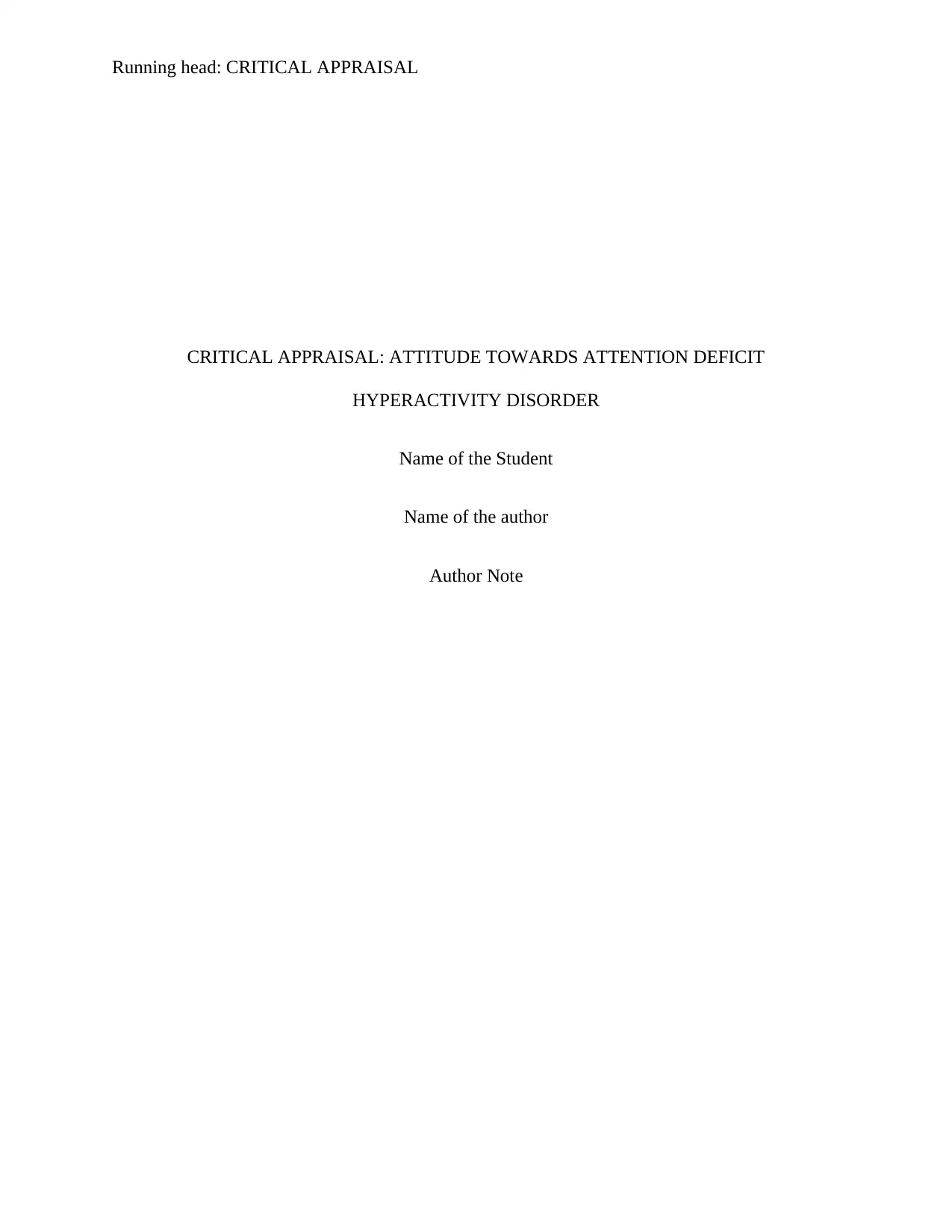
Running head: CRITICAL APPRAISAL
CRITICAL APPRAISAL: ATTITUDE TOWARDS ATTENTION DEFICIT
HYPERACTIVITY DISORDER
Name of the Student
Name of the author
Author Note
CRITICAL APPRAISAL: ATTITUDE TOWARDS ATTENTION DEFICIT
HYPERACTIVITY DISORDER
Name of the Student
Name of the author
Author Note
Paraphrase This Document
Need a fresh take? Get an instant paraphrase of this document with our AI Paraphraser
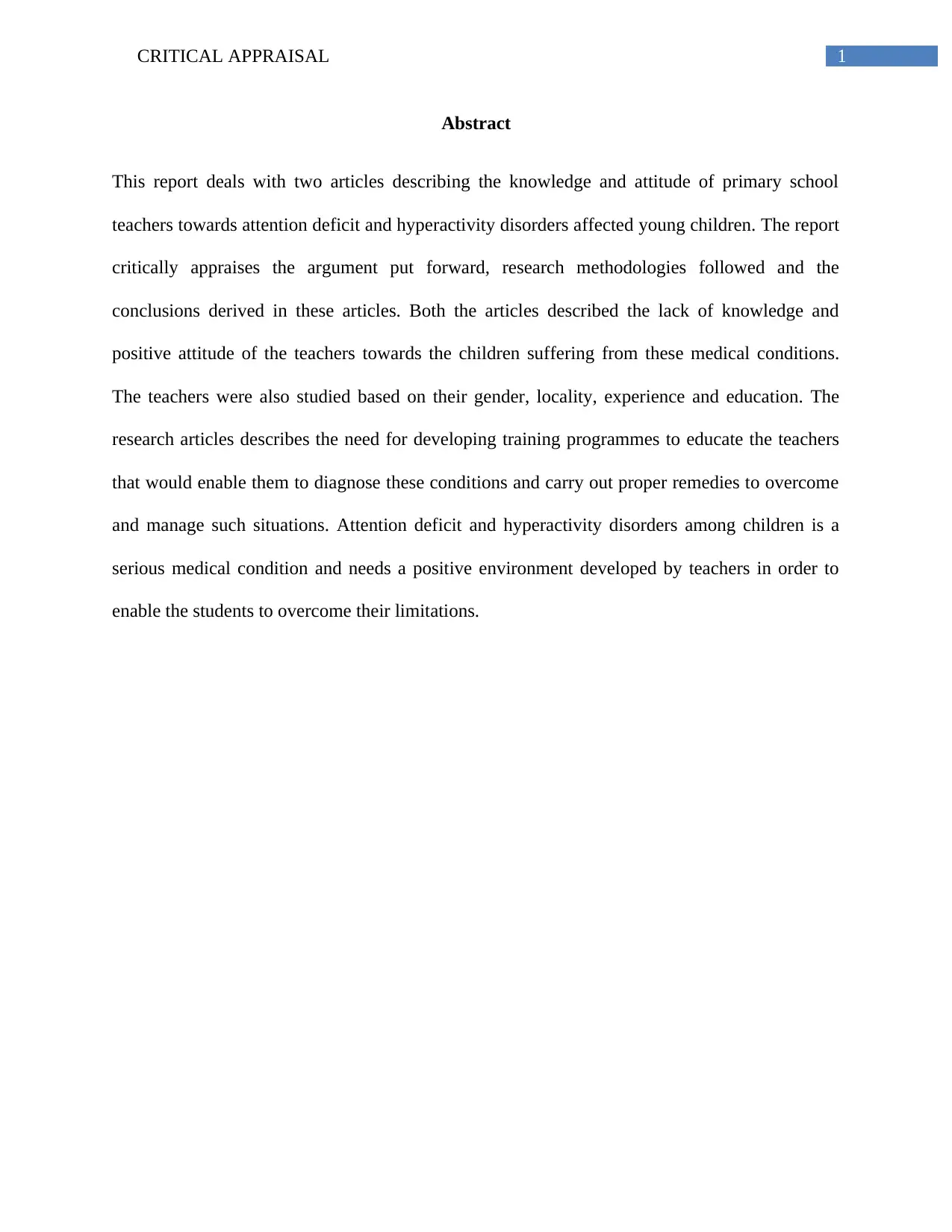
1CRITICAL APPRAISAL
Abstract
This report deals with two articles describing the knowledge and attitude of primary school
teachers towards attention deficit and hyperactivity disorders affected young children. The report
critically appraises the argument put forward, research methodologies followed and the
conclusions derived in these articles. Both the articles described the lack of knowledge and
positive attitude of the teachers towards the children suffering from these medical conditions.
The teachers were also studied based on their gender, locality, experience and education. The
research articles describes the need for developing training programmes to educate the teachers
that would enable them to diagnose these conditions and carry out proper remedies to overcome
and manage such situations. Attention deficit and hyperactivity disorders among children is a
serious medical condition and needs a positive environment developed by teachers in order to
enable the students to overcome their limitations.
Abstract
This report deals with two articles describing the knowledge and attitude of primary school
teachers towards attention deficit and hyperactivity disorders affected young children. The report
critically appraises the argument put forward, research methodologies followed and the
conclusions derived in these articles. Both the articles described the lack of knowledge and
positive attitude of the teachers towards the children suffering from these medical conditions.
The teachers were also studied based on their gender, locality, experience and education. The
research articles describes the need for developing training programmes to educate the teachers
that would enable them to diagnose these conditions and carry out proper remedies to overcome
and manage such situations. Attention deficit and hyperactivity disorders among children is a
serious medical condition and needs a positive environment developed by teachers in order to
enable the students to overcome their limitations.
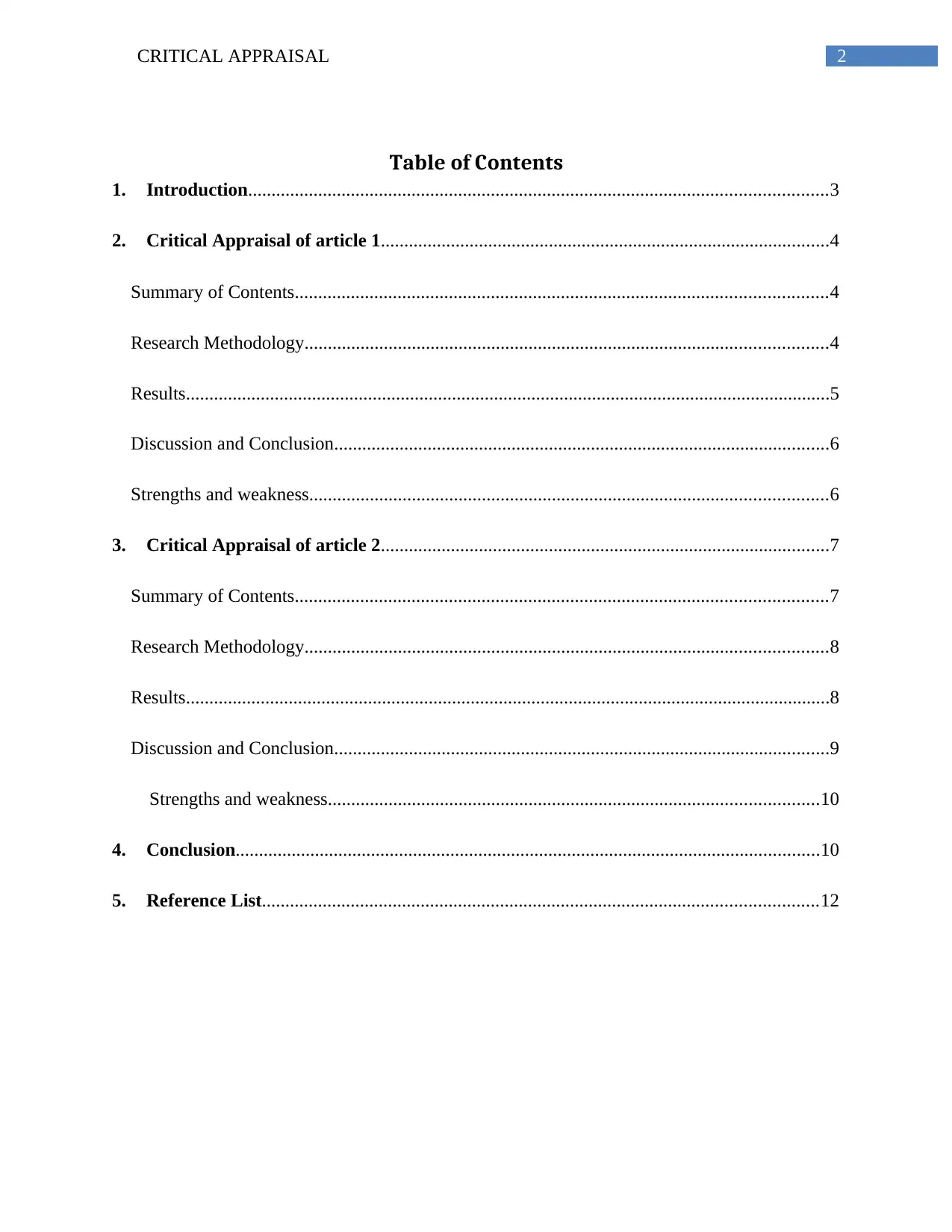
2CRITICAL APPRAISAL
Table of Contents
1. Introduction............................................................................................................................3
2. Critical Appraisal of article 1................................................................................................4
Summary of Contents..................................................................................................................4
Research Methodology................................................................................................................4
Results..........................................................................................................................................5
Discussion and Conclusion..........................................................................................................6
Strengths and weakness...............................................................................................................6
3. Critical Appraisal of article 2................................................................................................7
Summary of Contents..................................................................................................................7
Research Methodology................................................................................................................8
Results..........................................................................................................................................8
Discussion and Conclusion..........................................................................................................9
Strengths and weakness.........................................................................................................10
4. Conclusion.............................................................................................................................10
5. Reference List.......................................................................................................................12
Table of Contents
1. Introduction............................................................................................................................3
2. Critical Appraisal of article 1................................................................................................4
Summary of Contents..................................................................................................................4
Research Methodology................................................................................................................4
Results..........................................................................................................................................5
Discussion and Conclusion..........................................................................................................6
Strengths and weakness...............................................................................................................6
3. Critical Appraisal of article 2................................................................................................7
Summary of Contents..................................................................................................................7
Research Methodology................................................................................................................8
Results..........................................................................................................................................8
Discussion and Conclusion..........................................................................................................9
Strengths and weakness.........................................................................................................10
4. Conclusion.............................................................................................................................10
5. Reference List.......................................................................................................................12
⊘ This is a preview!⊘
Do you want full access?
Subscribe today to unlock all pages.

Trusted by 1+ million students worldwide
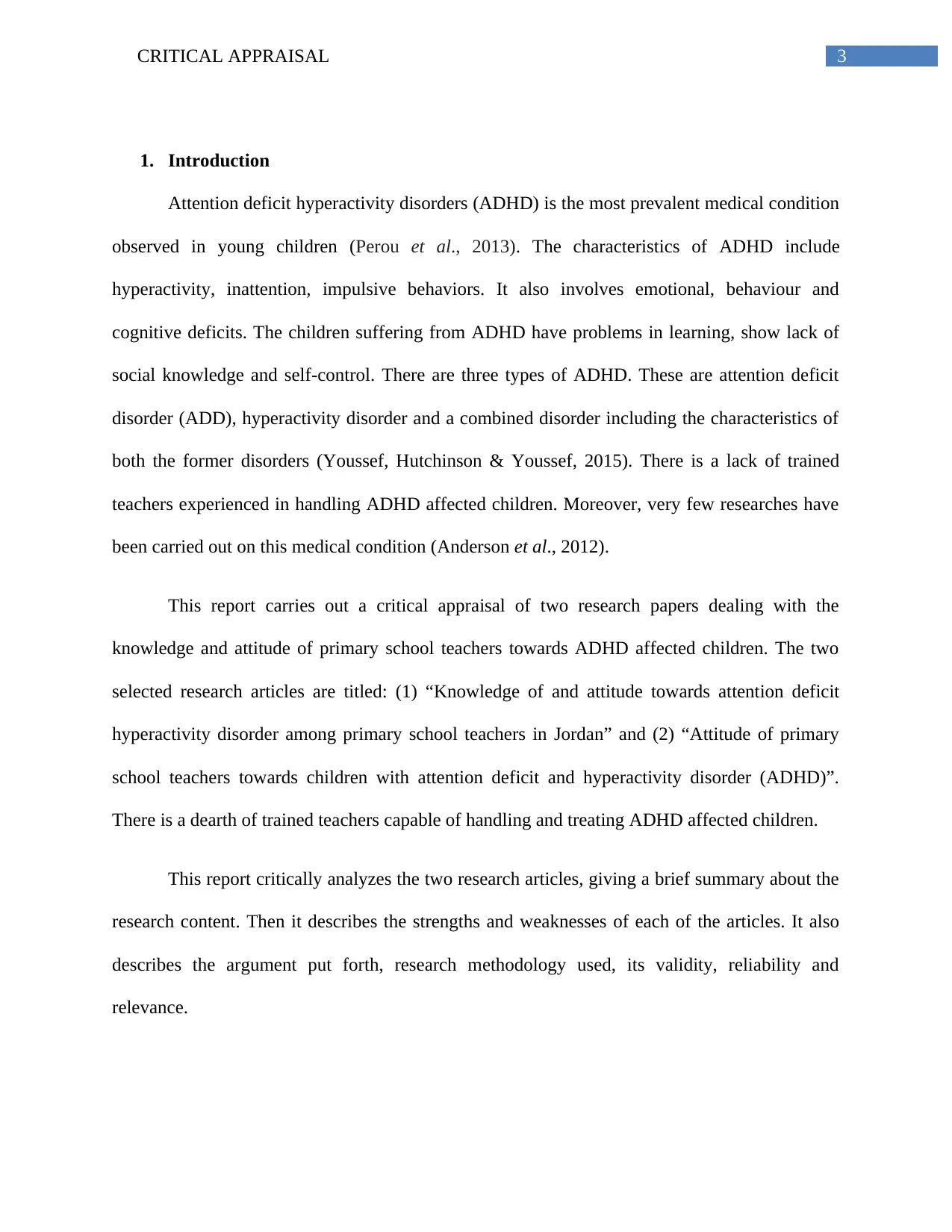
3CRITICAL APPRAISAL
1. Introduction
Attention deficit hyperactivity disorders (ADHD) is the most prevalent medical condition
observed in young children (Perou et al., 2013). The characteristics of ADHD include
hyperactivity, inattention, impulsive behaviors. It also involves emotional, behaviour and
cognitive deficits. The children suffering from ADHD have problems in learning, show lack of
social knowledge and self-control. There are three types of ADHD. These are attention deficit
disorder (ADD), hyperactivity disorder and a combined disorder including the characteristics of
both the former disorders (Youssef, Hutchinson & Youssef, 2015). There is a lack of trained
teachers experienced in handling ADHD affected children. Moreover, very few researches have
been carried out on this medical condition (Anderson et al., 2012).
This report carries out a critical appraisal of two research papers dealing with the
knowledge and attitude of primary school teachers towards ADHD affected children. The two
selected research articles are titled: (1) “Knowledge of and attitude towards attention deficit
hyperactivity disorder among primary school teachers in Jordan” and (2) “Attitude of primary
school teachers towards children with attention deficit and hyperactivity disorder (ADHD)”.
There is a dearth of trained teachers capable of handling and treating ADHD affected children.
This report critically analyzes the two research articles, giving a brief summary about the
research content. Then it describes the strengths and weaknesses of each of the articles. It also
describes the argument put forth, research methodology used, its validity, reliability and
relevance.
1. Introduction
Attention deficit hyperactivity disorders (ADHD) is the most prevalent medical condition
observed in young children (Perou et al., 2013). The characteristics of ADHD include
hyperactivity, inattention, impulsive behaviors. It also involves emotional, behaviour and
cognitive deficits. The children suffering from ADHD have problems in learning, show lack of
social knowledge and self-control. There are three types of ADHD. These are attention deficit
disorder (ADD), hyperactivity disorder and a combined disorder including the characteristics of
both the former disorders (Youssef, Hutchinson & Youssef, 2015). There is a lack of trained
teachers experienced in handling ADHD affected children. Moreover, very few researches have
been carried out on this medical condition (Anderson et al., 2012).
This report carries out a critical appraisal of two research papers dealing with the
knowledge and attitude of primary school teachers towards ADHD affected children. The two
selected research articles are titled: (1) “Knowledge of and attitude towards attention deficit
hyperactivity disorder among primary school teachers in Jordan” and (2) “Attitude of primary
school teachers towards children with attention deficit and hyperactivity disorder (ADHD)”.
There is a dearth of trained teachers capable of handling and treating ADHD affected children.
This report critically analyzes the two research articles, giving a brief summary about the
research content. Then it describes the strengths and weaknesses of each of the articles. It also
describes the argument put forth, research methodology used, its validity, reliability and
relevance.
Paraphrase This Document
Need a fresh take? Get an instant paraphrase of this document with our AI Paraphraser
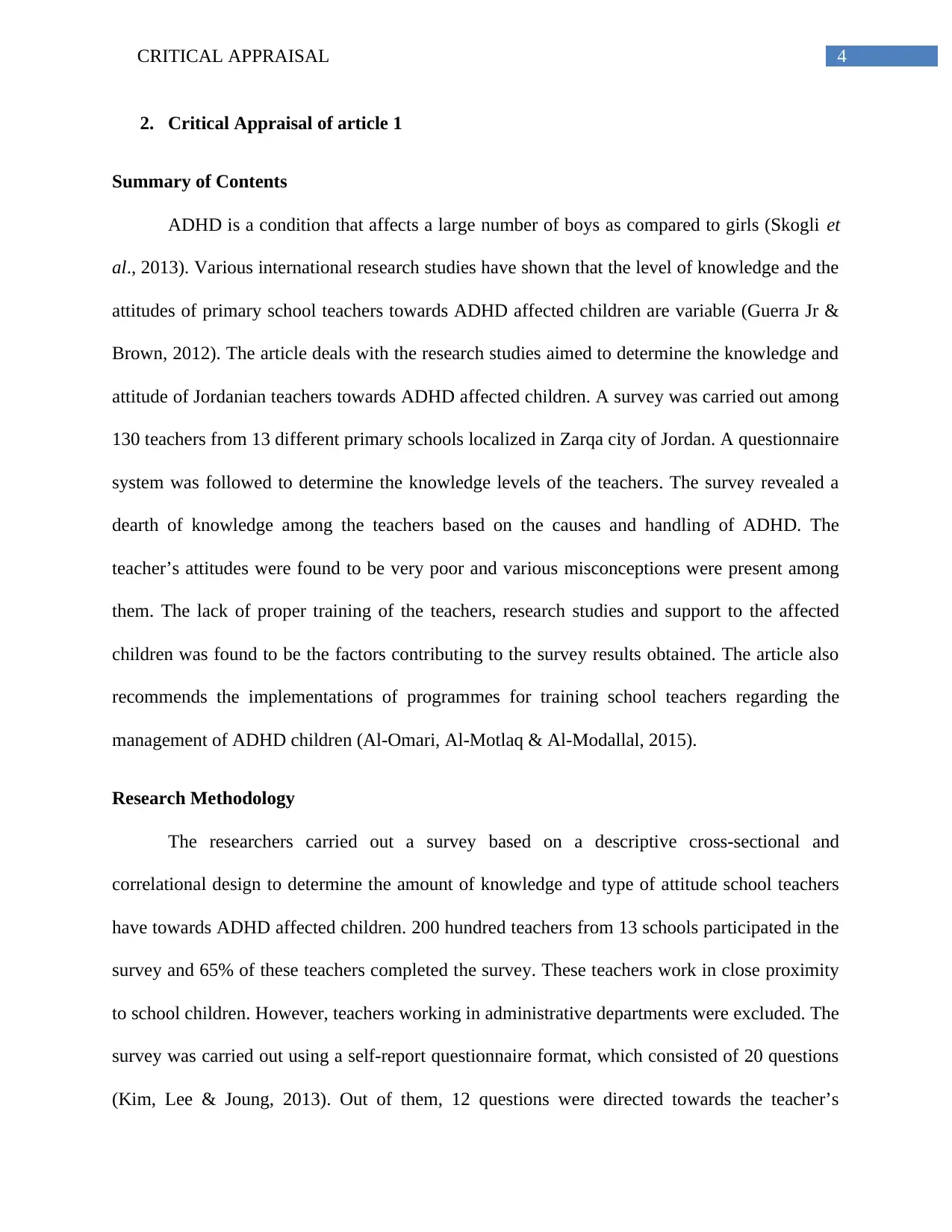
4CRITICAL APPRAISAL
2. Critical Appraisal of article 1
Summary of Contents
ADHD is a condition that affects a large number of boys as compared to girls (Skogli et
al., 2013). Various international research studies have shown that the level of knowledge and the
attitudes of primary school teachers towards ADHD affected children are variable (Guerra Jr &
Brown, 2012). The article deals with the research studies aimed to determine the knowledge and
attitude of Jordanian teachers towards ADHD affected children. A survey was carried out among
130 teachers from 13 different primary schools localized in Zarqa city of Jordan. A questionnaire
system was followed to determine the knowledge levels of the teachers. The survey revealed a
dearth of knowledge among the teachers based on the causes and handling of ADHD. The
teacher’s attitudes were found to be very poor and various misconceptions were present among
them. The lack of proper training of the teachers, research studies and support to the affected
children was found to be the factors contributing to the survey results obtained. The article also
recommends the implementations of programmes for training school teachers regarding the
management of ADHD children (Al-Omari, Al-Motlaq & Al-Modallal, 2015).
Research Methodology
The researchers carried out a survey based on a descriptive cross-sectional and
correlational design to determine the amount of knowledge and type of attitude school teachers
have towards ADHD affected children. 200 hundred teachers from 13 schools participated in the
survey and 65% of these teachers completed the survey. These teachers work in close proximity
to school children. However, teachers working in administrative departments were excluded. The
survey was carried out using a self-report questionnaire format, which consisted of 20 questions
(Kim, Lee & Joung, 2013). Out of them, 12 questions were directed towards the teacher’s
2. Critical Appraisal of article 1
Summary of Contents
ADHD is a condition that affects a large number of boys as compared to girls (Skogli et
al., 2013). Various international research studies have shown that the level of knowledge and the
attitudes of primary school teachers towards ADHD affected children are variable (Guerra Jr &
Brown, 2012). The article deals with the research studies aimed to determine the knowledge and
attitude of Jordanian teachers towards ADHD affected children. A survey was carried out among
130 teachers from 13 different primary schools localized in Zarqa city of Jordan. A questionnaire
system was followed to determine the knowledge levels of the teachers. The survey revealed a
dearth of knowledge among the teachers based on the causes and handling of ADHD. The
teacher’s attitudes were found to be very poor and various misconceptions were present among
them. The lack of proper training of the teachers, research studies and support to the affected
children was found to be the factors contributing to the survey results obtained. The article also
recommends the implementations of programmes for training school teachers regarding the
management of ADHD children (Al-Omari, Al-Motlaq & Al-Modallal, 2015).
Research Methodology
The researchers carried out a survey based on a descriptive cross-sectional and
correlational design to determine the amount of knowledge and type of attitude school teachers
have towards ADHD affected children. 200 hundred teachers from 13 schools participated in the
survey and 65% of these teachers completed the survey. These teachers work in close proximity
to school children. However, teachers working in administrative departments were excluded. The
survey was carried out using a self-report questionnaire format, which consisted of 20 questions
(Kim, Lee & Joung, 2013). Out of them, 12 questions were directed towards the teacher’s
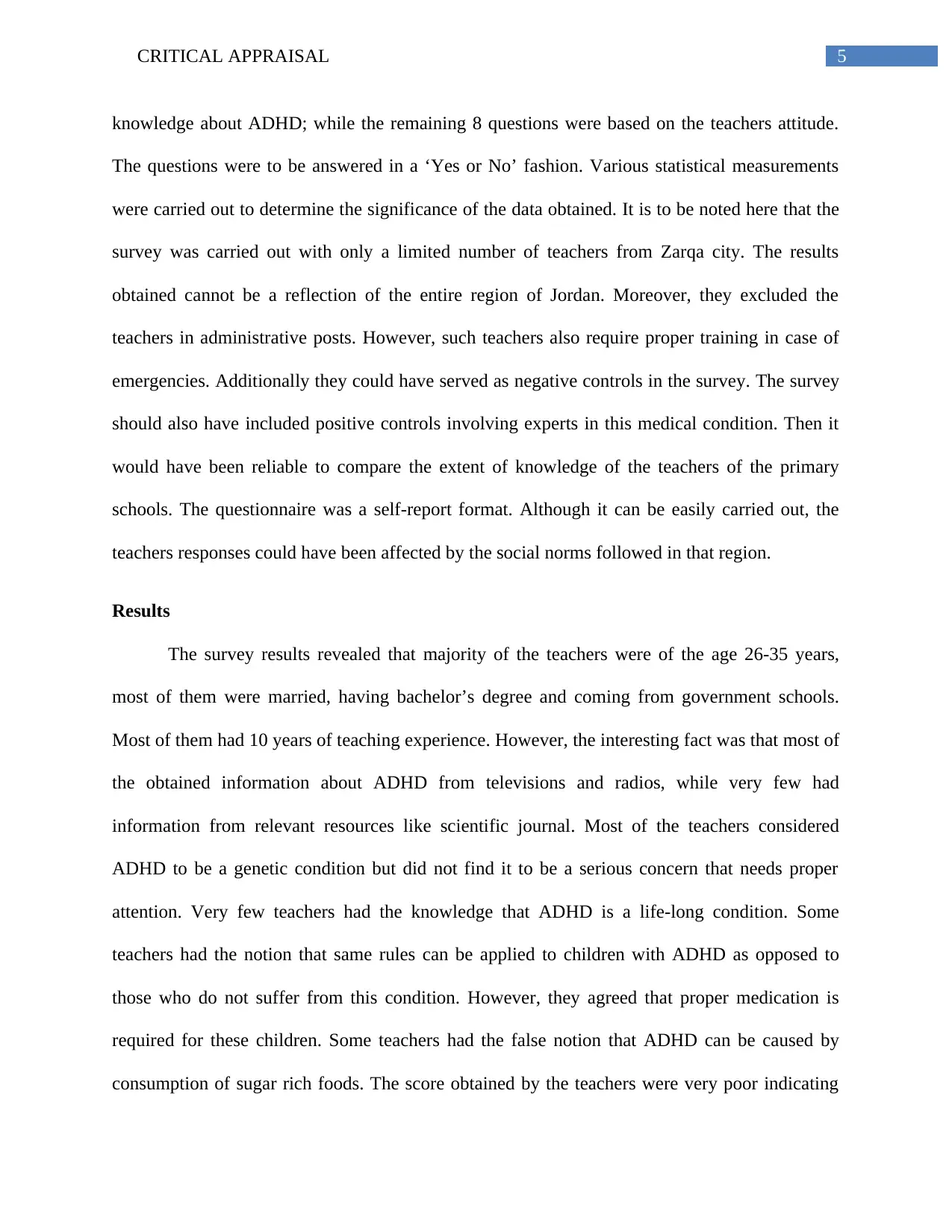
5CRITICAL APPRAISAL
knowledge about ADHD; while the remaining 8 questions were based on the teachers attitude.
The questions were to be answered in a ‘Yes or No’ fashion. Various statistical measurements
were carried out to determine the significance of the data obtained. It is to be noted here that the
survey was carried out with only a limited number of teachers from Zarqa city. The results
obtained cannot be a reflection of the entire region of Jordan. Moreover, they excluded the
teachers in administrative posts. However, such teachers also require proper training in case of
emergencies. Additionally they could have served as negative controls in the survey. The survey
should also have included positive controls involving experts in this medical condition. Then it
would have been reliable to compare the extent of knowledge of the teachers of the primary
schools. The questionnaire was a self-report format. Although it can be easily carried out, the
teachers responses could have been affected by the social norms followed in that region.
Results
The survey results revealed that majority of the teachers were of the age 26-35 years,
most of them were married, having bachelor’s degree and coming from government schools.
Most of them had 10 years of teaching experience. However, the interesting fact was that most of
the obtained information about ADHD from televisions and radios, while very few had
information from relevant resources like scientific journal. Most of the teachers considered
ADHD to be a genetic condition but did not find it to be a serious concern that needs proper
attention. Very few teachers had the knowledge that ADHD is a life-long condition. Some
teachers had the notion that same rules can be applied to children with ADHD as opposed to
those who do not suffer from this condition. However, they agreed that proper medication is
required for these children. Some teachers had the false notion that ADHD can be caused by
consumption of sugar rich foods. The score obtained by the teachers were very poor indicating
knowledge about ADHD; while the remaining 8 questions were based on the teachers attitude.
The questions were to be answered in a ‘Yes or No’ fashion. Various statistical measurements
were carried out to determine the significance of the data obtained. It is to be noted here that the
survey was carried out with only a limited number of teachers from Zarqa city. The results
obtained cannot be a reflection of the entire region of Jordan. Moreover, they excluded the
teachers in administrative posts. However, such teachers also require proper training in case of
emergencies. Additionally they could have served as negative controls in the survey. The survey
should also have included positive controls involving experts in this medical condition. Then it
would have been reliable to compare the extent of knowledge of the teachers of the primary
schools. The questionnaire was a self-report format. Although it can be easily carried out, the
teachers responses could have been affected by the social norms followed in that region.
Results
The survey results revealed that majority of the teachers were of the age 26-35 years,
most of them were married, having bachelor’s degree and coming from government schools.
Most of them had 10 years of teaching experience. However, the interesting fact was that most of
the obtained information about ADHD from televisions and radios, while very few had
information from relevant resources like scientific journal. Most of the teachers considered
ADHD to be a genetic condition but did not find it to be a serious concern that needs proper
attention. Very few teachers had the knowledge that ADHD is a life-long condition. Some
teachers had the notion that same rules can be applied to children with ADHD as opposed to
those who do not suffer from this condition. However, they agreed that proper medication is
required for these children. Some teachers had the false notion that ADHD can be caused by
consumption of sugar rich foods. The score obtained by the teachers were very poor indicating
⊘ This is a preview!⊘
Do you want full access?
Subscribe today to unlock all pages.

Trusted by 1+ million students worldwide
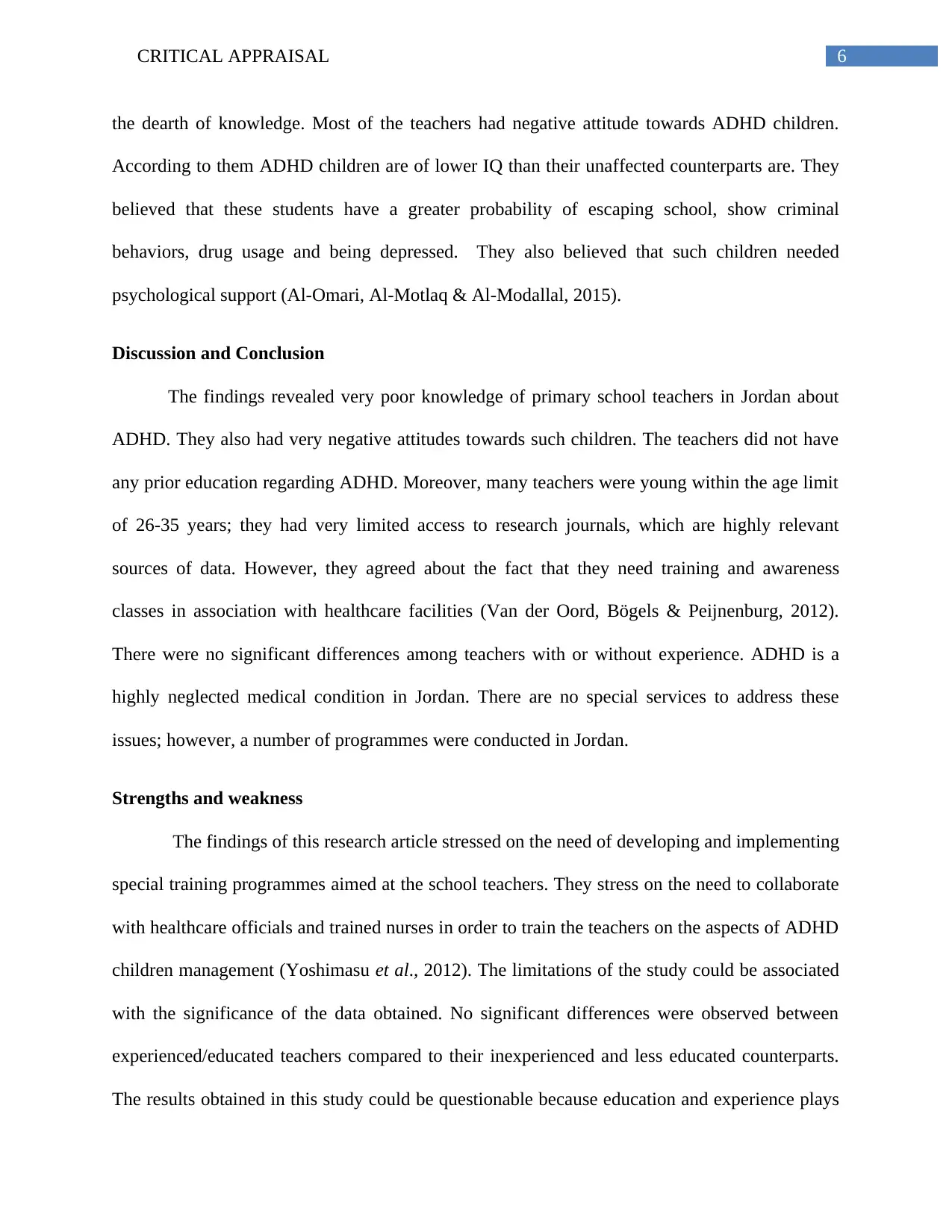
6CRITICAL APPRAISAL
the dearth of knowledge. Most of the teachers had negative attitude towards ADHD children.
According to them ADHD children are of lower IQ than their unaffected counterparts are. They
believed that these students have a greater probability of escaping school, show criminal
behaviors, drug usage and being depressed. They also believed that such children needed
psychological support (Al-Omari, Al-Motlaq & Al-Modallal, 2015).
Discussion and Conclusion
The findings revealed very poor knowledge of primary school teachers in Jordan about
ADHD. They also had very negative attitudes towards such children. The teachers did not have
any prior education regarding ADHD. Moreover, many teachers were young within the age limit
of 26-35 years; they had very limited access to research journals, which are highly relevant
sources of data. However, they agreed about the fact that they need training and awareness
classes in association with healthcare facilities (Van der Oord, Bögels & Peijnenburg, 2012).
There were no significant differences among teachers with or without experience. ADHD is a
highly neglected medical condition in Jordan. There are no special services to address these
issues; however, a number of programmes were conducted in Jordan.
Strengths and weakness
The findings of this research article stressed on the need of developing and implementing
special training programmes aimed at the school teachers. They stress on the need to collaborate
with healthcare officials and trained nurses in order to train the teachers on the aspects of ADHD
children management (Yoshimasu et al., 2012). The limitations of the study could be associated
with the significance of the data obtained. No significant differences were observed between
experienced/educated teachers compared to their inexperienced and less educated counterparts.
The results obtained in this study could be questionable because education and experience plays
the dearth of knowledge. Most of the teachers had negative attitude towards ADHD children.
According to them ADHD children are of lower IQ than their unaffected counterparts are. They
believed that these students have a greater probability of escaping school, show criminal
behaviors, drug usage and being depressed. They also believed that such children needed
psychological support (Al-Omari, Al-Motlaq & Al-Modallal, 2015).
Discussion and Conclusion
The findings revealed very poor knowledge of primary school teachers in Jordan about
ADHD. They also had very negative attitudes towards such children. The teachers did not have
any prior education regarding ADHD. Moreover, many teachers were young within the age limit
of 26-35 years; they had very limited access to research journals, which are highly relevant
sources of data. However, they agreed about the fact that they need training and awareness
classes in association with healthcare facilities (Van der Oord, Bögels & Peijnenburg, 2012).
There were no significant differences among teachers with or without experience. ADHD is a
highly neglected medical condition in Jordan. There are no special services to address these
issues; however, a number of programmes were conducted in Jordan.
Strengths and weakness
The findings of this research article stressed on the need of developing and implementing
special training programmes aimed at the school teachers. They stress on the need to collaborate
with healthcare officials and trained nurses in order to train the teachers on the aspects of ADHD
children management (Yoshimasu et al., 2012). The limitations of the study could be associated
with the significance of the data obtained. No significant differences were observed between
experienced/educated teachers compared to their inexperienced and less educated counterparts.
The results obtained in this study could be questionable because education and experience plays
Paraphrase This Document
Need a fresh take? Get an instant paraphrase of this document with our AI Paraphraser
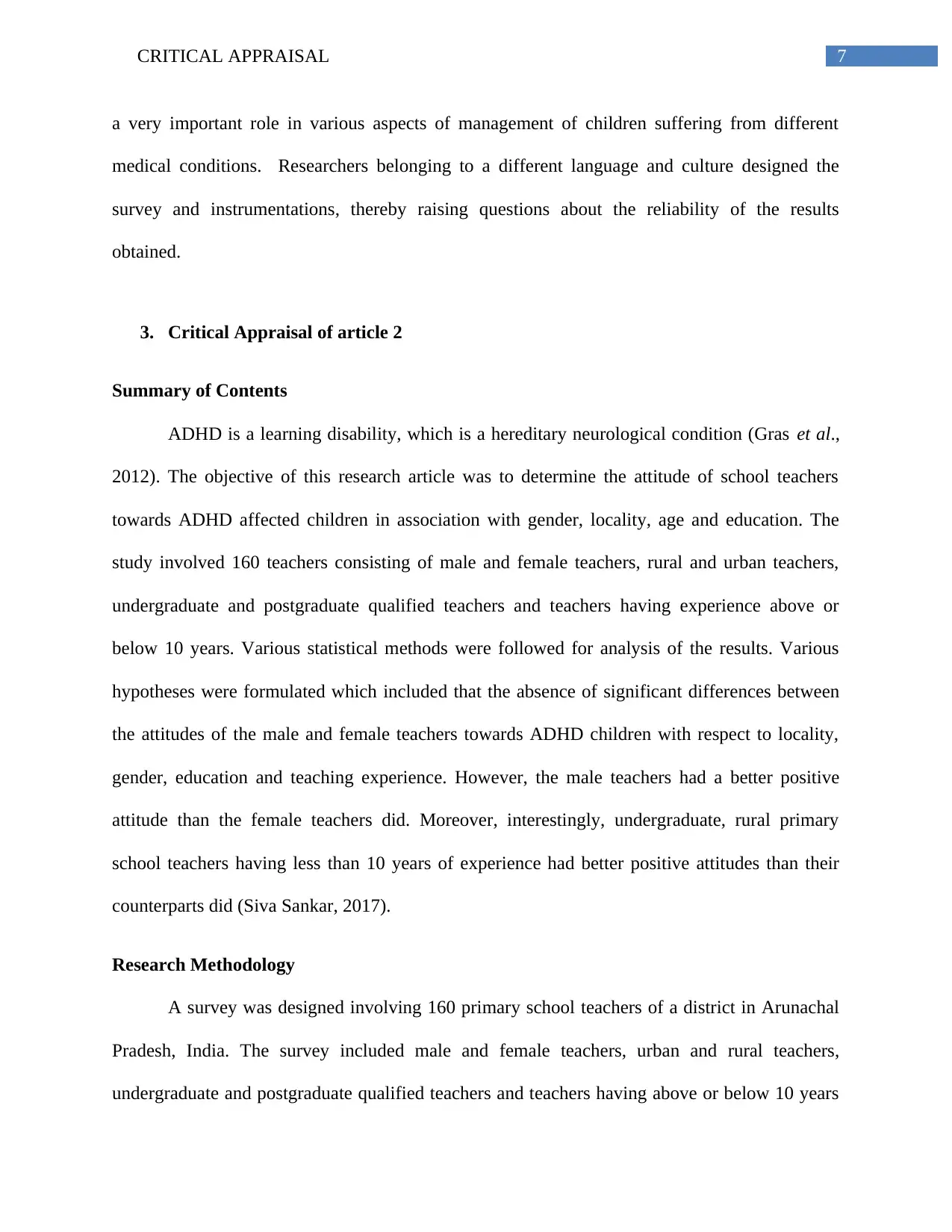
7CRITICAL APPRAISAL
a very important role in various aspects of management of children suffering from different
medical conditions. Researchers belonging to a different language and culture designed the
survey and instrumentations, thereby raising questions about the reliability of the results
obtained.
3. Critical Appraisal of article 2
Summary of Contents
ADHD is a learning disability, which is a hereditary neurological condition (Gras et al.,
2012). The objective of this research article was to determine the attitude of school teachers
towards ADHD affected children in association with gender, locality, age and education. The
study involved 160 teachers consisting of male and female teachers, rural and urban teachers,
undergraduate and postgraduate qualified teachers and teachers having experience above or
below 10 years. Various statistical methods were followed for analysis of the results. Various
hypotheses were formulated which included that the absence of significant differences between
the attitudes of the male and female teachers towards ADHD children with respect to locality,
gender, education and teaching experience. However, the male teachers had a better positive
attitude than the female teachers did. Moreover, interestingly, undergraduate, rural primary
school teachers having less than 10 years of experience had better positive attitudes than their
counterparts did (Siva Sankar, 2017).
Research Methodology
A survey was designed involving 160 primary school teachers of a district in Arunachal
Pradesh, India. The survey included male and female teachers, urban and rural teachers,
undergraduate and postgraduate qualified teachers and teachers having above or below 10 years
a very important role in various aspects of management of children suffering from different
medical conditions. Researchers belonging to a different language and culture designed the
survey and instrumentations, thereby raising questions about the reliability of the results
obtained.
3. Critical Appraisal of article 2
Summary of Contents
ADHD is a learning disability, which is a hereditary neurological condition (Gras et al.,
2012). The objective of this research article was to determine the attitude of school teachers
towards ADHD affected children in association with gender, locality, age and education. The
study involved 160 teachers consisting of male and female teachers, rural and urban teachers,
undergraduate and postgraduate qualified teachers and teachers having experience above or
below 10 years. Various statistical methods were followed for analysis of the results. Various
hypotheses were formulated which included that the absence of significant differences between
the attitudes of the male and female teachers towards ADHD children with respect to locality,
gender, education and teaching experience. However, the male teachers had a better positive
attitude than the female teachers did. Moreover, interestingly, undergraduate, rural primary
school teachers having less than 10 years of experience had better positive attitudes than their
counterparts did (Siva Sankar, 2017).
Research Methodology
A survey was designed involving 160 primary school teachers of a district in Arunachal
Pradesh, India. The survey included male and female teachers, urban and rural teachers,
undergraduate and postgraduate qualified teachers and teachers having above or below 10 years
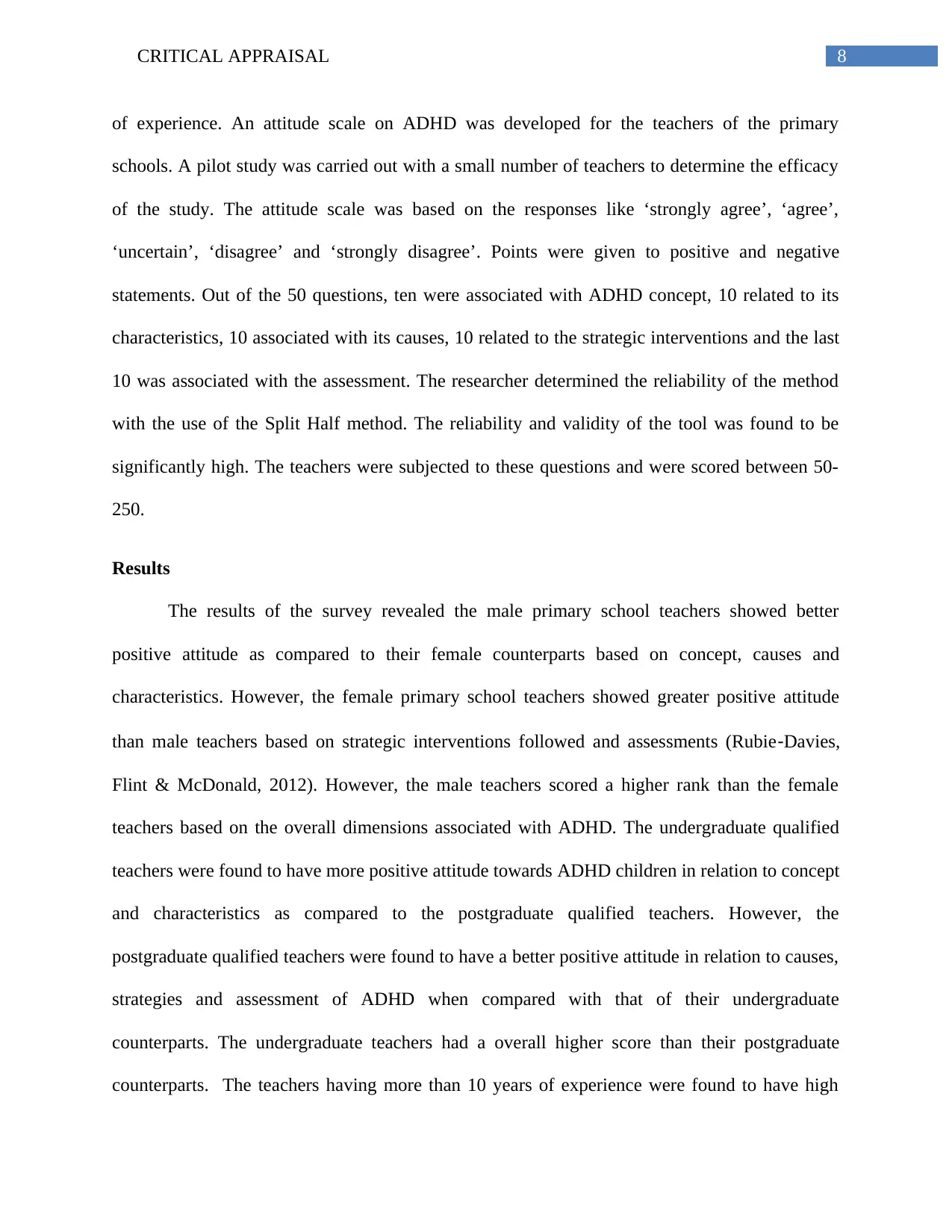
8CRITICAL APPRAISAL
of experience. An attitude scale on ADHD was developed for the teachers of the primary
schools. A pilot study was carried out with a small number of teachers to determine the efficacy
of the study. The attitude scale was based on the responses like ‘strongly agree’, ‘agree’,
‘uncertain’, ‘disagree’ and ‘strongly disagree’. Points were given to positive and negative
statements. Out of the 50 questions, ten were associated with ADHD concept, 10 related to its
characteristics, 10 associated with its causes, 10 related to the strategic interventions and the last
10 was associated with the assessment. The researcher determined the reliability of the method
with the use of the Split Half method. The reliability and validity of the tool was found to be
significantly high. The teachers were subjected to these questions and were scored between 50-
250.
Results
The results of the survey revealed the male primary school teachers showed better
positive attitude as compared to their female counterparts based on concept, causes and
characteristics. However, the female primary school teachers showed greater positive attitude
than male teachers based on strategic interventions followed and assessments (Rubie‐Davies,
Flint & McDonald, 2012). However, the male teachers scored a higher rank than the female
teachers based on the overall dimensions associated with ADHD. The undergraduate qualified
teachers were found to have more positive attitude towards ADHD children in relation to concept
and characteristics as compared to the postgraduate qualified teachers. However, the
postgraduate qualified teachers were found to have a better positive attitude in relation to causes,
strategies and assessment of ADHD when compared with that of their undergraduate
counterparts. The undergraduate teachers had a overall higher score than their postgraduate
counterparts. The teachers having more than 10 years of experience were found to have high
of experience. An attitude scale on ADHD was developed for the teachers of the primary
schools. A pilot study was carried out with a small number of teachers to determine the efficacy
of the study. The attitude scale was based on the responses like ‘strongly agree’, ‘agree’,
‘uncertain’, ‘disagree’ and ‘strongly disagree’. Points were given to positive and negative
statements. Out of the 50 questions, ten were associated with ADHD concept, 10 related to its
characteristics, 10 associated with its causes, 10 related to the strategic interventions and the last
10 was associated with the assessment. The researcher determined the reliability of the method
with the use of the Split Half method. The reliability and validity of the tool was found to be
significantly high. The teachers were subjected to these questions and were scored between 50-
250.
Results
The results of the survey revealed the male primary school teachers showed better
positive attitude as compared to their female counterparts based on concept, causes and
characteristics. However, the female primary school teachers showed greater positive attitude
than male teachers based on strategic interventions followed and assessments (Rubie‐Davies,
Flint & McDonald, 2012). However, the male teachers scored a higher rank than the female
teachers based on the overall dimensions associated with ADHD. The undergraduate qualified
teachers were found to have more positive attitude towards ADHD children in relation to concept
and characteristics as compared to the postgraduate qualified teachers. However, the
postgraduate qualified teachers were found to have a better positive attitude in relation to causes,
strategies and assessment of ADHD when compared with that of their undergraduate
counterparts. The undergraduate teachers had a overall higher score than their postgraduate
counterparts. The teachers having more than 10 years of experience were found to have high
⊘ This is a preview!⊘
Do you want full access?
Subscribe today to unlock all pages.

Trusted by 1+ million students worldwide
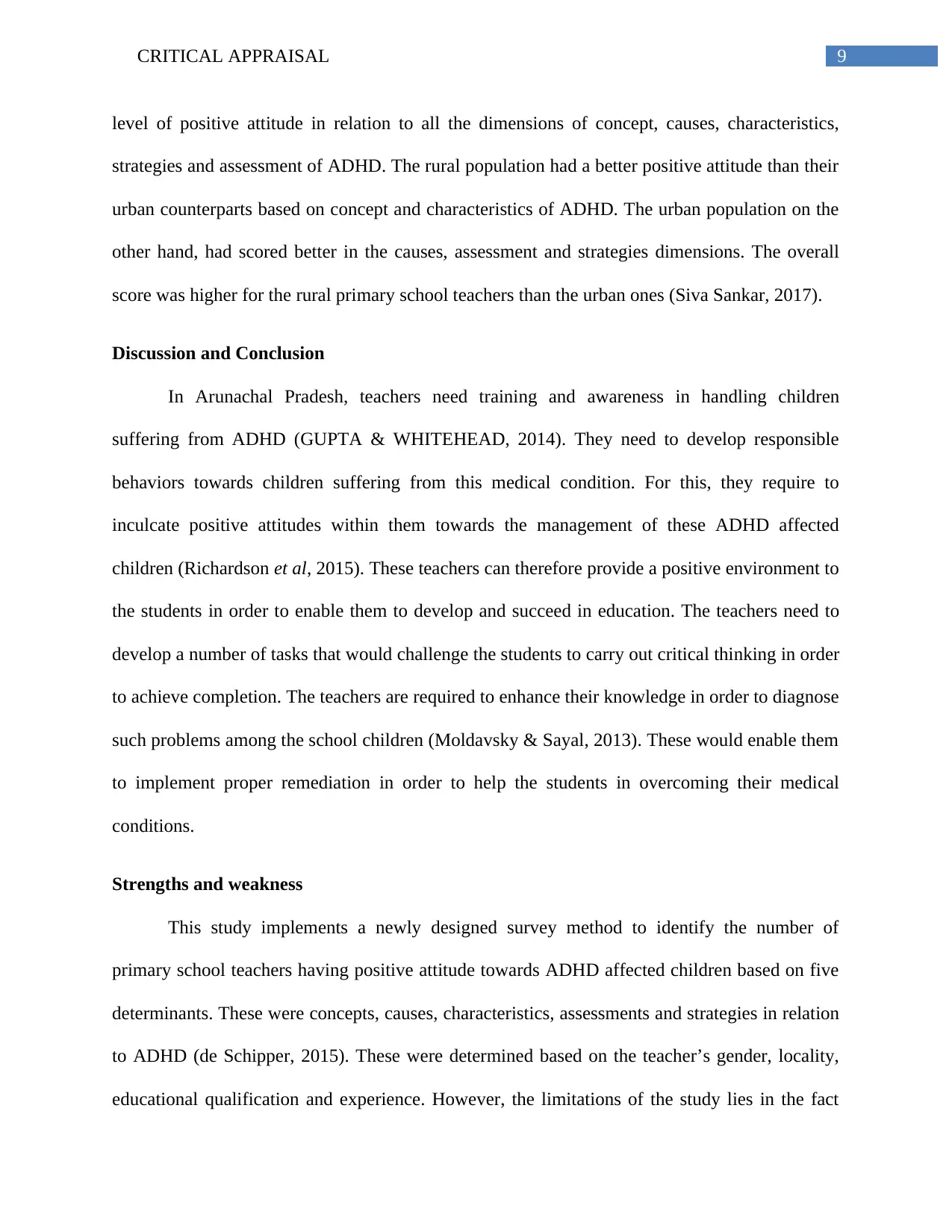
9CRITICAL APPRAISAL
level of positive attitude in relation to all the dimensions of concept, causes, characteristics,
strategies and assessment of ADHD. The rural population had a better positive attitude than their
urban counterparts based on concept and characteristics of ADHD. The urban population on the
other hand, had scored better in the causes, assessment and strategies dimensions. The overall
score was higher for the rural primary school teachers than the urban ones (Siva Sankar, 2017).
Discussion and Conclusion
In Arunachal Pradesh, teachers need training and awareness in handling children
suffering from ADHD (GUPTA & WHITEHEAD, 2014). They need to develop responsible
behaviors towards children suffering from this medical condition. For this, they require to
inculcate positive attitudes within them towards the management of these ADHD affected
children (Richardson et al, 2015). These teachers can therefore provide a positive environment to
the students in order to enable them to develop and succeed in education. The teachers need to
develop a number of tasks that would challenge the students to carry out critical thinking in order
to achieve completion. The teachers are required to enhance their knowledge in order to diagnose
such problems among the school children (Moldavsky & Sayal, 2013). These would enable them
to implement proper remediation in order to help the students in overcoming their medical
conditions.
Strengths and weakness
This study implements a newly designed survey method to identify the number of
primary school teachers having positive attitude towards ADHD affected children based on five
determinants. These were concepts, causes, characteristics, assessments and strategies in relation
to ADHD (de Schipper, 2015). These were determined based on the teacher’s gender, locality,
educational qualification and experience. However, the limitations of the study lies in the fact
level of positive attitude in relation to all the dimensions of concept, causes, characteristics,
strategies and assessment of ADHD. The rural population had a better positive attitude than their
urban counterparts based on concept and characteristics of ADHD. The urban population on the
other hand, had scored better in the causes, assessment and strategies dimensions. The overall
score was higher for the rural primary school teachers than the urban ones (Siva Sankar, 2017).
Discussion and Conclusion
In Arunachal Pradesh, teachers need training and awareness in handling children
suffering from ADHD (GUPTA & WHITEHEAD, 2014). They need to develop responsible
behaviors towards children suffering from this medical condition. For this, they require to
inculcate positive attitudes within them towards the management of these ADHD affected
children (Richardson et al, 2015). These teachers can therefore provide a positive environment to
the students in order to enable them to develop and succeed in education. The teachers need to
develop a number of tasks that would challenge the students to carry out critical thinking in order
to achieve completion. The teachers are required to enhance their knowledge in order to diagnose
such problems among the school children (Moldavsky & Sayal, 2013). These would enable them
to implement proper remediation in order to help the students in overcoming their medical
conditions.
Strengths and weakness
This study implements a newly designed survey method to identify the number of
primary school teachers having positive attitude towards ADHD affected children based on five
determinants. These were concepts, causes, characteristics, assessments and strategies in relation
to ADHD (de Schipper, 2015). These were determined based on the teacher’s gender, locality,
educational qualification and experience. However, the limitations of the study lies in the fact
Paraphrase This Document
Need a fresh take? Get an instant paraphrase of this document with our AI Paraphraser
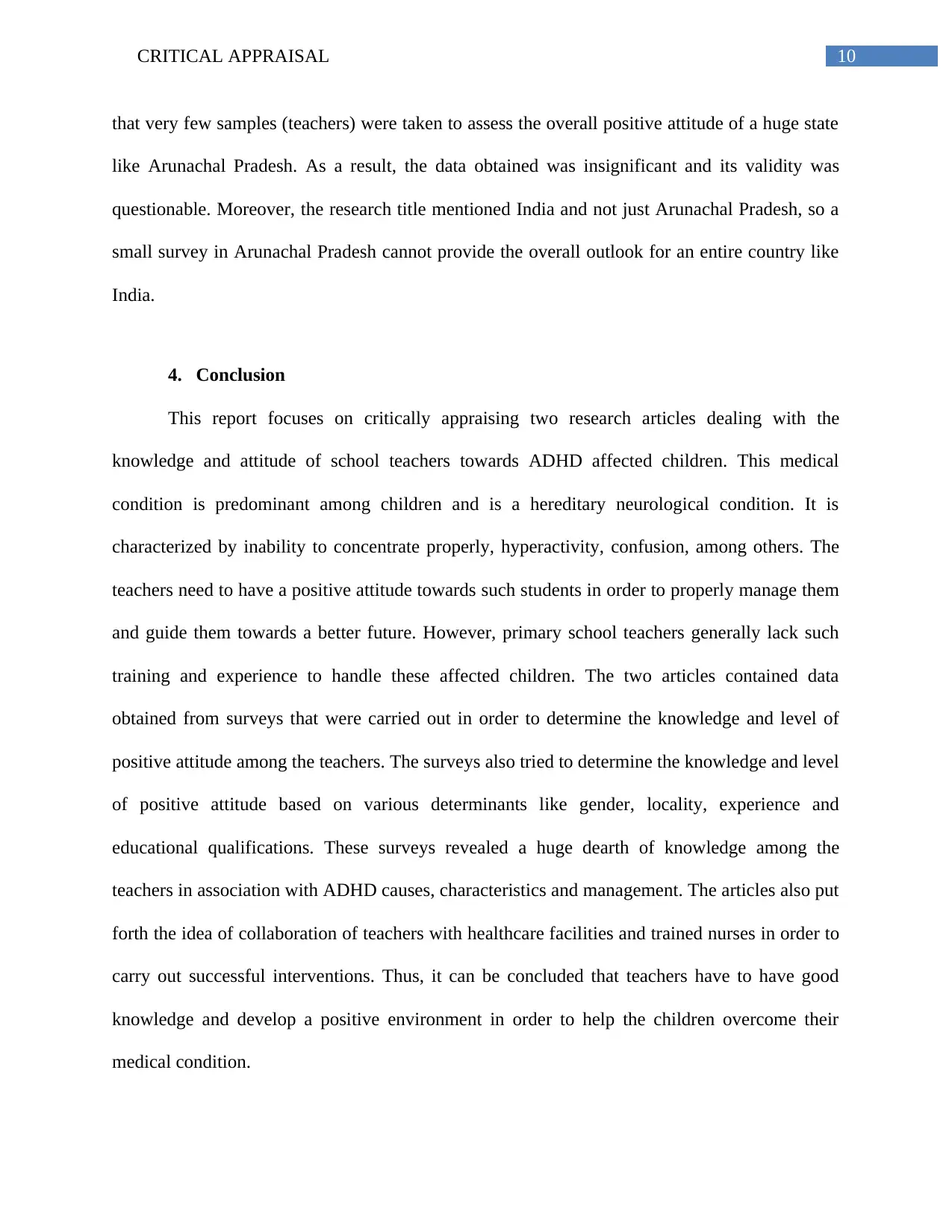
10CRITICAL APPRAISAL
that very few samples (teachers) were taken to assess the overall positive attitude of a huge state
like Arunachal Pradesh. As a result, the data obtained was insignificant and its validity was
questionable. Moreover, the research title mentioned India and not just Arunachal Pradesh, so a
small survey in Arunachal Pradesh cannot provide the overall outlook for an entire country like
India.
4. Conclusion
This report focuses on critically appraising two research articles dealing with the
knowledge and attitude of school teachers towards ADHD affected children. This medical
condition is predominant among children and is a hereditary neurological condition. It is
characterized by inability to concentrate properly, hyperactivity, confusion, among others. The
teachers need to have a positive attitude towards such students in order to properly manage them
and guide them towards a better future. However, primary school teachers generally lack such
training and experience to handle these affected children. The two articles contained data
obtained from surveys that were carried out in order to determine the knowledge and level of
positive attitude among the teachers. The surveys also tried to determine the knowledge and level
of positive attitude based on various determinants like gender, locality, experience and
educational qualifications. These surveys revealed a huge dearth of knowledge among the
teachers in association with ADHD causes, characteristics and management. The articles also put
forth the idea of collaboration of teachers with healthcare facilities and trained nurses in order to
carry out successful interventions. Thus, it can be concluded that teachers have to have good
knowledge and develop a positive environment in order to help the children overcome their
medical condition.
that very few samples (teachers) were taken to assess the overall positive attitude of a huge state
like Arunachal Pradesh. As a result, the data obtained was insignificant and its validity was
questionable. Moreover, the research title mentioned India and not just Arunachal Pradesh, so a
small survey in Arunachal Pradesh cannot provide the overall outlook for an entire country like
India.
4. Conclusion
This report focuses on critically appraising two research articles dealing with the
knowledge and attitude of school teachers towards ADHD affected children. This medical
condition is predominant among children and is a hereditary neurological condition. It is
characterized by inability to concentrate properly, hyperactivity, confusion, among others. The
teachers need to have a positive attitude towards such students in order to properly manage them
and guide them towards a better future. However, primary school teachers generally lack such
training and experience to handle these affected children. The two articles contained data
obtained from surveys that were carried out in order to determine the knowledge and level of
positive attitude among the teachers. The surveys also tried to determine the knowledge and level
of positive attitude based on various determinants like gender, locality, experience and
educational qualifications. These surveys revealed a huge dearth of knowledge among the
teachers in association with ADHD causes, characteristics and management. The articles also put
forth the idea of collaboration of teachers with healthcare facilities and trained nurses in order to
carry out successful interventions. Thus, it can be concluded that teachers have to have good
knowledge and develop a positive environment in order to help the children overcome their
medical condition.
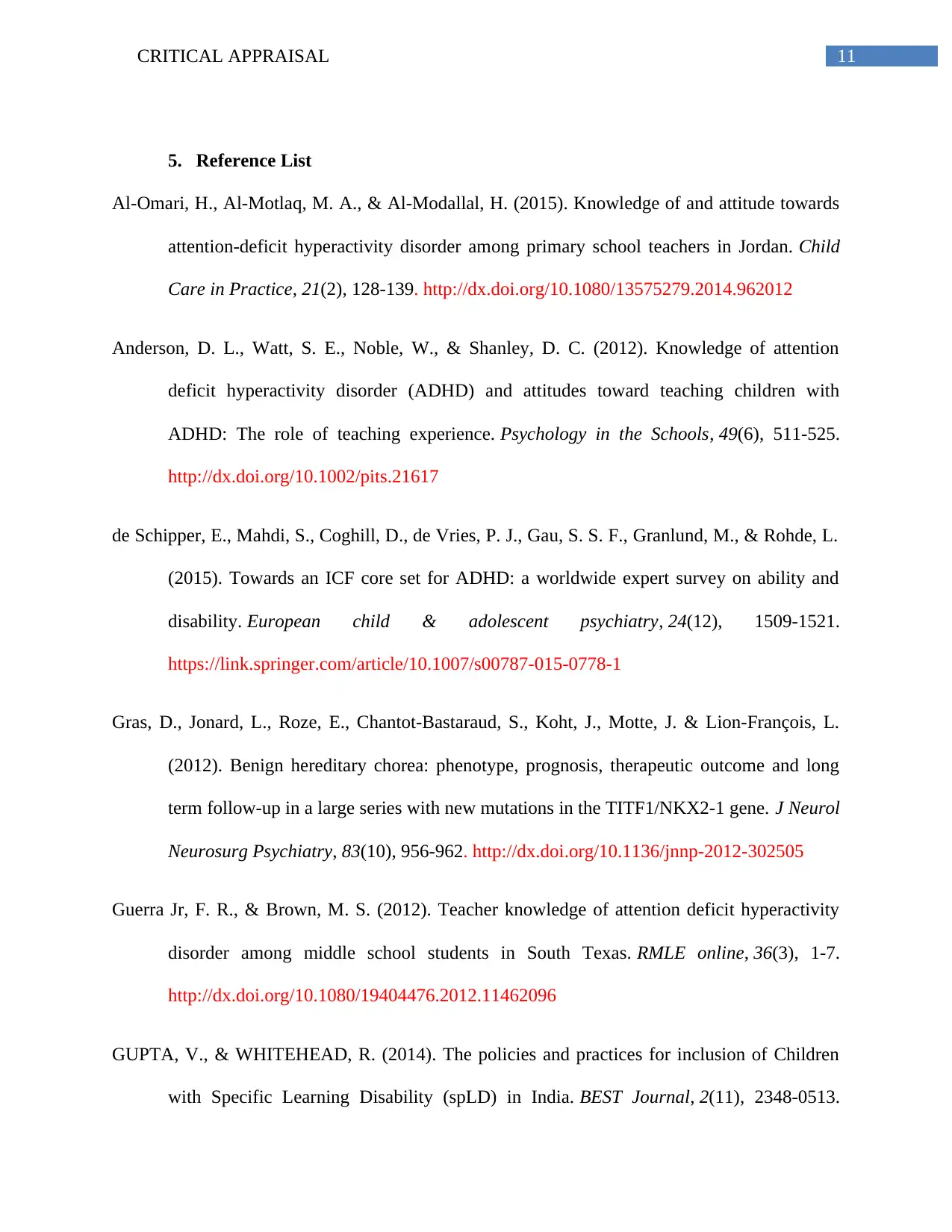
11CRITICAL APPRAISAL
5. Reference List
Al-Omari, H., Al-Motlaq, M. A., & Al-Modallal, H. (2015). Knowledge of and attitude towards
attention-deficit hyperactivity disorder among primary school teachers in Jordan. Child
Care in Practice, 21(2), 128-139. http://dx.doi.org/10.1080/13575279.2014.962012
Anderson, D. L., Watt, S. E., Noble, W., & Shanley, D. C. (2012). Knowledge of attention
deficit hyperactivity disorder (ADHD) and attitudes toward teaching children with
ADHD: The role of teaching experience. Psychology in the Schools, 49(6), 511-525.
http://dx.doi.org/10.1002/pits.21617
de Schipper, E., Mahdi, S., Coghill, D., de Vries, P. J., Gau, S. S. F., Granlund, M., & Rohde, L.
(2015). Towards an ICF core set for ADHD: a worldwide expert survey on ability and
disability. European child & adolescent psychiatry, 24(12), 1509-1521.
https://link.springer.com/article/10.1007/s00787-015-0778-1
Gras, D., Jonard, L., Roze, E., Chantot-Bastaraud, S., Koht, J., Motte, J. & Lion-François, L.
(2012). Benign hereditary chorea: phenotype, prognosis, therapeutic outcome and long
term follow-up in a large series with new mutations in the TITF1/NKX2-1 gene. J Neurol
Neurosurg Psychiatry, 83(10), 956-962. http://dx.doi.org/10.1136/jnnp-2012-302505
Guerra Jr, F. R., & Brown, M. S. (2012). Teacher knowledge of attention deficit hyperactivity
disorder among middle school students in South Texas. RMLE online, 36(3), 1-7.
http://dx.doi.org/10.1080/19404476.2012.11462096
GUPTA, V., & WHITEHEAD, R. (2014). The policies and practices for inclusion of Children
with Specific Learning Disability (spLD) in India. BEST Journal, 2(11), 2348-0513.
5. Reference List
Al-Omari, H., Al-Motlaq, M. A., & Al-Modallal, H. (2015). Knowledge of and attitude towards
attention-deficit hyperactivity disorder among primary school teachers in Jordan. Child
Care in Practice, 21(2), 128-139. http://dx.doi.org/10.1080/13575279.2014.962012
Anderson, D. L., Watt, S. E., Noble, W., & Shanley, D. C. (2012). Knowledge of attention
deficit hyperactivity disorder (ADHD) and attitudes toward teaching children with
ADHD: The role of teaching experience. Psychology in the Schools, 49(6), 511-525.
http://dx.doi.org/10.1002/pits.21617
de Schipper, E., Mahdi, S., Coghill, D., de Vries, P. J., Gau, S. S. F., Granlund, M., & Rohde, L.
(2015). Towards an ICF core set for ADHD: a worldwide expert survey on ability and
disability. European child & adolescent psychiatry, 24(12), 1509-1521.
https://link.springer.com/article/10.1007/s00787-015-0778-1
Gras, D., Jonard, L., Roze, E., Chantot-Bastaraud, S., Koht, J., Motte, J. & Lion-François, L.
(2012). Benign hereditary chorea: phenotype, prognosis, therapeutic outcome and long
term follow-up in a large series with new mutations in the TITF1/NKX2-1 gene. J Neurol
Neurosurg Psychiatry, 83(10), 956-962. http://dx.doi.org/10.1136/jnnp-2012-302505
Guerra Jr, F. R., & Brown, M. S. (2012). Teacher knowledge of attention deficit hyperactivity
disorder among middle school students in South Texas. RMLE online, 36(3), 1-7.
http://dx.doi.org/10.1080/19404476.2012.11462096
GUPTA, V., & WHITEHEAD, R. (2014). The policies and practices for inclusion of Children
with Specific Learning Disability (spLD) in India. BEST Journal, 2(11), 2348-0513.
⊘ This is a preview!⊘
Do you want full access?
Subscribe today to unlock all pages.

Trusted by 1+ million students worldwide
1 out of 15
Related Documents
Your All-in-One AI-Powered Toolkit for Academic Success.
+13062052269
info@desklib.com
Available 24*7 on WhatsApp / Email
![[object Object]](/_next/static/media/star-bottom.7253800d.svg)
Unlock your academic potential
Copyright © 2020–2025 A2Z Services. All Rights Reserved. Developed and managed by ZUCOL.





